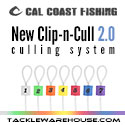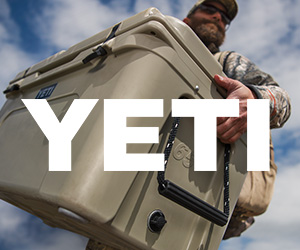|
Predator
Research Laboratories draws on hydrodynamics to build their newest Shrimp lures
(continued)

 Retrieve:
These lures
make use of the “InterFlow” which is engineered based on aqua-dynamics, where
water compression creates the essential energy for us to recreate the prey-like
characteristics. Upon retrieval, water is forced through the larger front intake
manifolds and forced out via the smaller exits in the lure. PR-Labs believes
that the generated energy enhances the realism of their lures. Retrieve:
These lures
make use of the “InterFlow” which is engineered based on aqua-dynamics, where
water compression creates the essential energy for us to recreate the prey-like
characteristics. Upon retrieval, water is forced through the larger front intake
manifolds and forced out via the smaller exits in the lure. PR-Labs believes
that the generated energy enhances the realism of their lures.

Notice the holes in the
head...this is where the water jets out as the lure is retrieved
This lure is
best fished well over or outside of structure, as the bait makes use of two
exposed trebles which will hang up easily in vegetation. When retrieving we
noticed the lure had a slight side to side action, but for the most part didn’t
rock side by side all that much. This is due to the evenly weighted
characteristics of the lure and the flat bill.

A look at the Shrimp's unique
profile
If there was a
weight system in this lure and a slightly curved bill the bait would whip back
and forth more aggressively. This was not PR Lab’s intent however, as they
wanted to create a subtle presentation, one more like a real retreating shrimp.
As water shoots through the chamber it does cause the lure to emit some sound,
though not something that anglers will hear. But the question is will fish?

The paint transitions beautifully
on the "Blue Green" Supernova model
We retrieved
the lures with slow and fast retrieves, and even added in pauses and jerks. We
didn’t like the lure when burned as there is just about no action at all, and
had little success fishing it when retrieved very fast. This may be a good
technique when targeting saltwater species, but we found our local largemouth
and stripers uninterested in the lure when it was on the move quickly. In
our opinion there are two really effective ways to fish the PRL Shrimp. The
first is a consistent slow retrieve which allows the lure to move back and forth
consistently with water moving through the chamber. We were able to get both
largemouth and stripers to pursue and commit.

The cracked finish on the
Radiation "Glow Yellow" pattern even shows through when glowing in the dark
Another method
is to vary the retrieve with slight pauses, this proved much more effective for
largemouth than stripers. In terms of colors we found the metallic’s much better
for stripers, and the broken up radiation glow patterns for largemouth best for
bass. The most effective pattern for stripers was the red head and blue green.
The glow orange was by far the most effectual color for largemouth, followed by
the glow yellow, which really is similar to chartreuse. While the stripers might
actually think the lure is indeed a shrimp, we believe the fish attack the lure
because it simply looks flashy in the water when retrieved. When it comes to
largemouth we believe that our local fish believe the lure is not a shrimp, but
rather a retreating crawdad. Nevertheless the fish did eat them.

If you look closely you can see
the clear coat that protects the lure's finish
Price &
Applications: Because the lure doesn’t put out audible noise (at least to
anglers) we had a lot more confidence fishing these lures in calm and clearer
conditions. The Interflow design is supposed to work well in murky conditions
but we definitely had the most success in clearer water. In windy conditions it
would be nice to have a weighted model, with a system that would enable the lure
to get deeper and make noise to call fish in. While we appreciate what PR Labs
is trying to accomplish with their hi-tech design, we think that another series
with the Interflow system plus a weight exchange knocker system would make the
lure more attractive for a wider range of species. These hand crafted lures
retail for 12.90 for the 7cm model, and a dollar more for the larger 9 cm
Shrimp, a reasonable price for an imported lure. If you do want to pick up a few
you’re unlikely to find them stateside, and instead the best way to get some are
direct from the manufacturer.

When retrieved with pauses bass
seem to commit more to the Shrimp, perhaps they really do think it is a craw
If you spend
time to learn more about this manufacturer it is obvious that the company has a
passion for two things… technology and art. These two attributes come together
in just about every lure the company makes, and their offerings are quite unlike
anything else in the market. The original Shrimp lures were mostly treated Teak
or Sono, or accented with mother of pearl. The lures were beautiful, and would
look great in any collector’s case. We fished these original lures and found
them to be more form than function, but all of that changed with the new
finishes. The brightly colored Super Nova series made use of metallic paint to
create a much flashier lure, and the radiation series featured cracked design
that really stands out as it glows brightly in the dark. These new finished
immediately increased the lure’s effectiveness on local species, and will likely
do so on many more fish, both fresh and saltwater.
Ratings:
|
Predator
Lab's Shrimp Ratings
(?/10) |
| Construction/Quality |
The Predator labs lures are well done with quality carved wooden bodies. The
finishes are also quite impressive and much nicer than the original. We
didn't encounter durability issues, and the Radiation series glowed just
like it was supposed to |
9 |
| Performance |
The
new finishes performed far better than the original wood lures. While we can
debate the reasons why fish are attracted to the lures, both largemouth bass
and stripers attacked the lures during our tests once we got the retrieve
down |
8 |
| Price |
Not
cheap, but inline with some of the Japanese imported lures. It also is hard
to find locally |
7 |
| Features |
The
main feature of this lure is the patent pending Interflow design. We think
other additional strike triggers could really put this lure over the edge,
but for now the system does prove effective |
8 |
| Design
(Ergonomics) |
The
Shrimp is easy to fish, but once again a weight system would add elements of
noise as well as improve castability and the ability of fish the lure in a
greater range of strike zones |
8 |
| Application |
The Shrimp worked for local freshwater species and we will continue to test
it on possible saltwater applications |
8 |
|
Total Score |
8.00 |
Pluses and Minuses:
|
Plus
Minus |
| J
Unique technology and design |
L
A weight system would improve casting |
| J
Much improved finishes |
L
Added features could add strike triggers |
| J
Ability to target multiple species |
|
| J
Fish haven't seen it before |
|

A largemouth caught with the Glow
Yellow pattern on the Delta
Conclusion:
Predator Labs has done a
lot of work studying how fish target prey, as well as how shrimp move in nature.
The Shrimp line of lures finally hits primetime when the company took their
Interflow design and combined it with a quality array of finishes. The new
Supernova series increases strikes with a much more visually attractive design,
while the radiation series mimics crustaceans much better, making it appealing
to freshwater fish that prey on crawdads. Bass and Stripers that once only
showed a smidgen of interest in the lures immediately started attacking the
baits. We commend PR Labs for combining both technology and art together in a
lure that stands apart from the rest of the field. While we do believe in the
positive features of Interflow design we can’t help but think in some
circumstances added features like a more aggressive lip for quicker diving or a
weighted bead chamber would add additional strike triggers into a lure with a
unique profile. We have no doubt that the company is far from done when it comes
to innovating, but for now the Shrimp lures are a very interesting proposition,
and a bait that few fish or fishermen have seen yet. Which can be a very good
thing when pursuing fish in heavily targeted bodies of water.


|


























